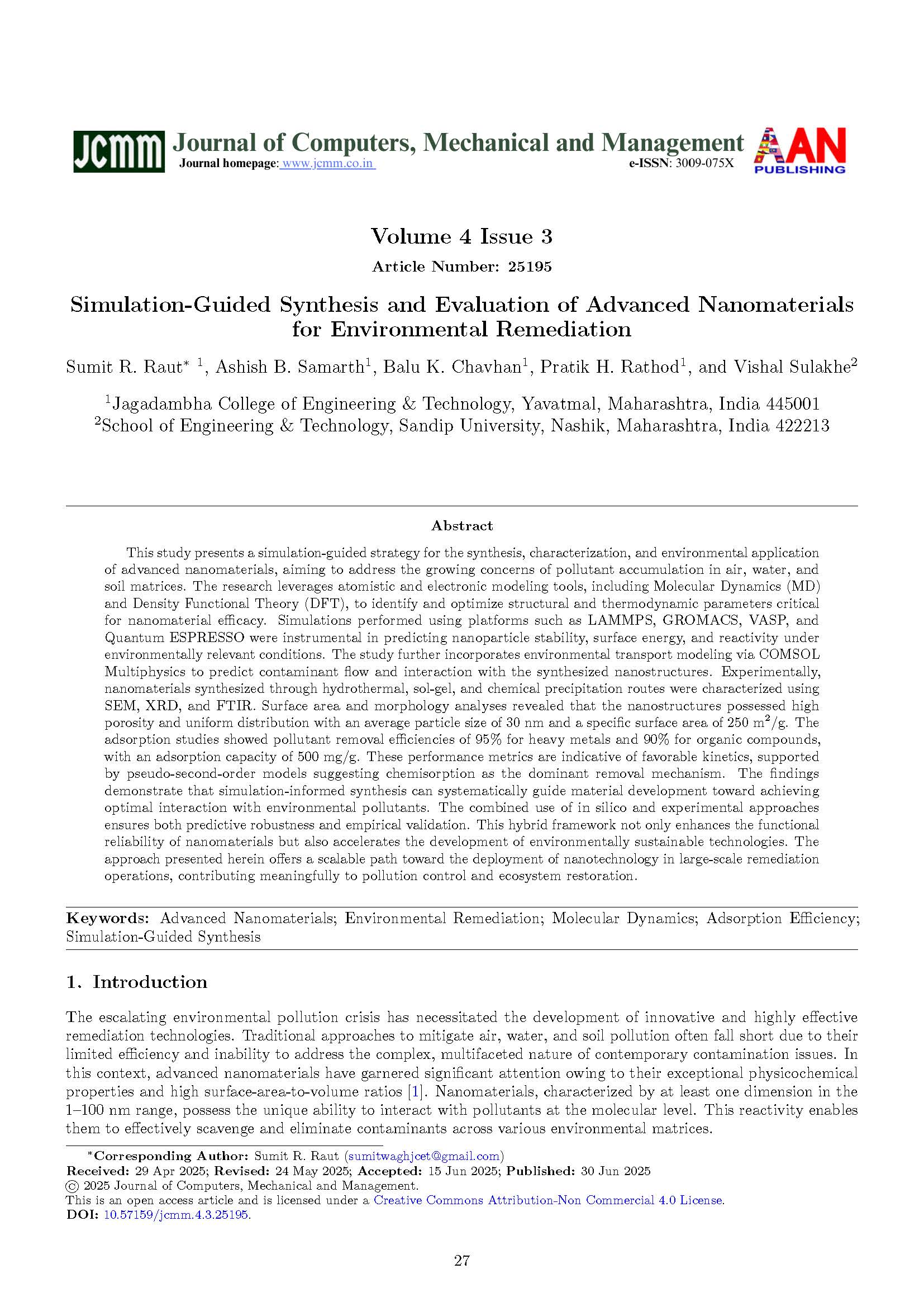Simulation-Guided Synthesis and Evaluation of Advanced Nanomaterials for Environmental Remediation
DOI:
https://doi.org/10.57159/jcmm.4.3.25195Keywords:
Advanced Nanomaterials, Environmental Remediation, Molecular Dynamics, Adsorption Efficiency, Simulation-Guided SynthesisAbstract
This study presents a simulation-guided strategy for the synthesis, characterization, and environmental application of advanced nanomaterials, aiming to address the growing concerns of pollutant accumulation in air, water, and soil matrices. The research leverages atomistic and electronic modeling tools, including Molecular Dynamics (MD) and Density Functional Theory (DFT), to identify and optimize structural and thermodynamic parameters critical for nanomaterial efficacy. Simulations performed using platforms such as LAMMPS, GROMACS, VASP, and Quantum ESPRESSO were instrumental in predicting nanoparticle stability, surface energy, and reactivity under environmentally relevant conditions. The study further incorporates environmental transport modeling via COMSOL Multiphysics to predict contaminant flow and interaction with the synthesized nanostructures. Experimentally, nanomaterials synthesized through hydrothermal, sol-gel, and chemical precipitation routes were characterized using SEM, XRD, and FTIR. Surface area and morphology analyses revealed that the nanostructures possessed high porosity and uniform distribution with an average particle size of 30 nm and a specific surface area of 250 m2/g. The adsorption studies showed pollutant removal efficiencies of 95% for heavy metals and 90% for organic compounds, with an adsorption capacity of 500 mg/g. These performance metrics are indicative of favorable kinetics, supported by pseudo-second-order models suggesting chemisorption as the dominant removal mechanism. The findings demonstrate that simulation-informed synthesis can systematically guide material development toward achieving optimal interaction with environmental pollutants. The combined use of in silico and experimental approaches ensures both predictive robustness and empirical validation. This hybrid framework not only enhances the functional reliability of nanomaterials but also accelerates the development of environmentally sustainable technologies. The approach presented herein offers a scalable path toward the deployment of nanotechnology in large-scale remediation operations, contributing meaningfully to pollution control and ecosystem restoration.
References
T. Liyanage, A. Z. Qamar, and G. Slaughter, “Application of nanomaterials for chemical and biological sensors: A review,” IEEE Sensors Journal, vol. 21, no. 11, pp. 12407–12425, 2021.
Q. Wu, M. Zhang, and Z. Zheng, “All-fiber, all-optical ultrafast switch based on two-dimensional nanomaterials,” in 2021 Conference on Lasers and Electro-Optics (CLEO), San Jose, CA, USA, pp. 1–2, 2021.
N. S. Powar, A. Chaeeun, and S.-I. In, “A comprehensive exploration of nanomaterials in cosmetics,” IEEE Nanotechnology Magazine, vol. 18, pp. 15–26, Aug. 2024.
A. Reimers et al., “Multifunctional devices based on 3D hybrid networks of ZnO and 3D carbon nanomaterials,” in 2023 IEEE 13th International Conference Nanomaterials: Applications & Properties (NAP), Bratislava, Slovakia, pp. NN01–1–NN01–4, 2023.
S. Hermann, S. Böttger, and J. Albrecht, “Controlling strain in suspended nanomaterials,” in 2023 IEEE International Interconnect Technology Conference (IITC) and IEEE Materials for Advanced Metallization (MAM), Dresden, Germany, pp. 1–4, 2023.
C. Sharma et al., “Synergistic antibacterial effects of cellulose: TiO₂ nanocomposite against phytopathogens,” in 2022 IEEE 12th International Conference Nanomaterials: Applications & Properties (NAP), Krakow, Poland, pp. 1–5, 2022.
D. A. Y. Agyapong, K. Mensah-Darkwa, F. M. Souza, and R. K. Gupta, “Hybrid nanomaterials for biosensor applications,” in Organic and Inorganic Materials Based Sensors, 3 Volumes, Wiley, pp. 453–478, 2024.
A. V. Orlov, “Low-dimensional magnetic structures as sensing nanoprobes for advanced bioapplications,” in 2024 International Conference Laser Optics (ICLO), Saint Petersburg, Russian Federation, pp. 536–536, 2024.
F. Frank et al., “A dedicated mixed-signal characterisation and testing framework for novel digital security circuits that use carbon-nanotube-based physical unclonable functions,” in 2022 11th International Conference on Modern Circuits and Systems Technologies (MOCAST), Bremen, Germany, pp. 1–4, 2022.
K. Lebedeva, A. Cherkashina, A. Voronkin, V. Lebedev, N. Klochko, and A. Masikevych, “Design and researching smart biologically active polymeric hydrogel transdermal nanomaterials,” in 2023 IEEE 4th KhPI Week on Advanced Technology (KhPIWeek), Kharkiv, Ukraine, pp. 1–5, 2023.
M. R. Rozbu, A. Kabir, and P. M. Selvakumar, “Functionalized bio-carbon nanomaterials for environmental utilizations,” in Environmental Applications of Carbon Nanomaterials-Based Devices, Wiley, pp. 347–374, 2021.
S. K. Srivastava and V. Mittal, “Advanced nanostructured materials in electromagnetic interference shielding,” in Hybrid Nanomaterials: Advances in Energy, Environment, and Polymer Nanocomposites, Wiley, pp. 241–320, 2017.
M. Vaka, T. R. B. Ramakrishna, K. Mohammad, and R. Walvekar, “Low-dimensional carbon nanomaterials: Synthesis, properties, and applications related to heat transfer, energy harvesting, and energy storage,” in Spectroscopy and Characterization of Nanomaterials and Novel Materials, Wiley, pp. 33–53, 2022.
N. Kuthala, “2D nanomaterials for cancer therapy,” in 2D Functional Nanomaterials: Synthesis, Characterization, and Applications, Wiley, pp. 63–79, 2022.
H. Ren et al., “High-reliability wireless packaging for high-temperature SiC power device sintered by novel organic-free nanomaterial,” IEEE Transactions on Components, Packaging and Manufacturing Technology, vol. 10, pp. 1953–1959, Dec. 2020.
A. N. Woodberry and F. E. Mensah, “Applications of nanomaterials in nanomedicine,” in Spectroscopy and Characterization of Nanomaterials and Novel Materials, Wiley, pp. 345–360, 2022.
P. K. D. Pramanik, A. Solanki, A. Debnath, A. Nayyar, S. El-Sappagh, and K.-S. Kwak, “Advancing modern healthcare with nanotechnology, nanobiosensors, and Internet of Nano Things: Taxonomies, applications, architecture, and challenges,” IEEE Access, vol. 8, pp. 65230–65266, 2020.

Downloads
Published
How to Cite
License
Copyright (c) 2025 Journal of Computers, Mechanical and Management

This work is licensed under a Creative Commons Attribution-NonCommercial 4.0 International License.
The Journal of Computers, Mechanical and Management applies the CC Attribution- Non-Commercial 4.0 International License to its published articles. While retaining copyright ownership of the content, the journal permits activities such as downloading, reusing, reprinting, modifying, distributing, and copying of the articles, as long as the original authors and source are appropriately cited. Proper attribution is ensured by citing the original publication.





